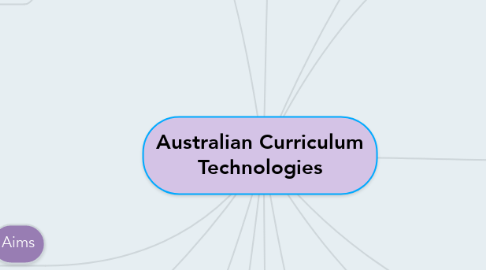
1. Strands
1.1. Knowledge and Understanding
1.2. Processes and Production Skills
2. Cross-Curricular Priorities
2.1. Asia and Australias engagement with asia
2.2. Sustainabiltiy
2.3. Aboriginal and Torres Strait Islander histories and Cultures
3. student Diversity
3.1. The curriculum accommodated for students with different learning requirements. Modifications are made for students with disabilities, gifted and talented, Indigenous and students who speak English as an additional language.
4. Content
4.1. Design and Technologies
4.1.1. Knowledge and Understanding
4.1.1.1. Technologies and Society
4.1.1.2. Technologies and Contexts
4.1.2. Process and Production Skills
4.1.2.1. Investigating
4.1.2.2. Generating
4.1.2.3. Producing
4.1.2.4. Evaluating
4.1.2.5. Collaborating and Managing
4.2. Digital Technologies
4.2.1. Knowledge and Undertsanding
4.2.1.1. Digital Systems
4.2.1.1.1. Hardware, software, networks and their uses
4.2.1.2. Representation of Data
4.2.1.2.1. How data is represented and structured symbolically
4.2.2. Process and Production Skills
4.2.2.1. Collecting, managing and analysing data. Creating digital solutions
4.2.2.1.1. Defining
4.2.2.1.2. Designing
4.2.2.1.3. Implementing
4.2.2.1.4. Evaluating
4.2.2.1.5. Collaborating and Managing
5. Aims
5.1. Investigate, design, plan, manage, create and evaluate solutions
5.2. Use and design systems thinking to generate design ideas and communicate these to a range of audiences
5.3. Make informed and ethical decisions about the role, impact and use of the technologies in the economy, environment and society for a sustainable future.
5.4. Critique, analyse and evaluate problems, needs or opportunities to identify and create solutions.
5.5. Evaluate processes and designed solutions and transfer knowledge and skills to new situations
5.6. Understand the roles and responsibilities of people in design and technologies occupations and how they contribute to society.
6. Links to other learning areas
6.1. English
6.2. Mathematics
6.3. Science
6.4. History
6.5. Geography
6.6. The Arts
6.7. Health and Physical education
6.8. Economics and Business
7. Content Descriptors
7.1. The descriptors describe knowledge, understanding, and skills that all teachers are expected to learn.
8. Key ideas
8.1. Preferred futures
8.1.1. prepare students for future technologies and jobs
8.1.2. Develop skills to identify possible and probable futures
8.2. Thinking in Technologies
8.2.1. System thinking
8.2.2. Computational Thinking
8.2.3. Design Thinking
8.3. Safety
8.4. Animal Ethics
8.5. Project Management
9. Band Levels
9.1. The curriculum for each Technologies subject is written in bands of year levels. The bands provide an overview of the content for each year level
9.1.1. Foundation to Year 2
9.1.2. Years 3 and 4
9.1.3. Years 5 and 6
9.1.4. Years 7 and 8
9.1.5. Years 9 and 10
